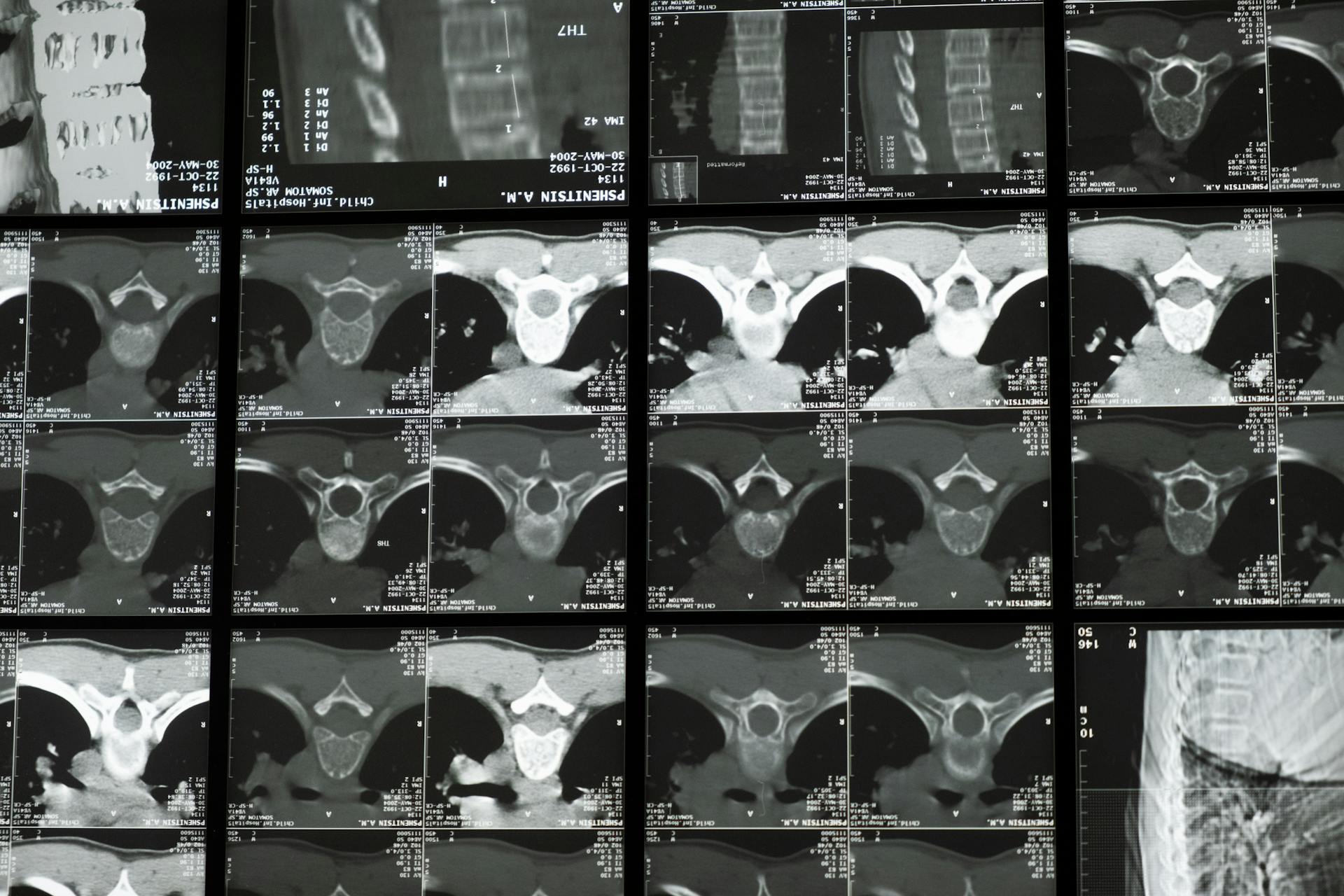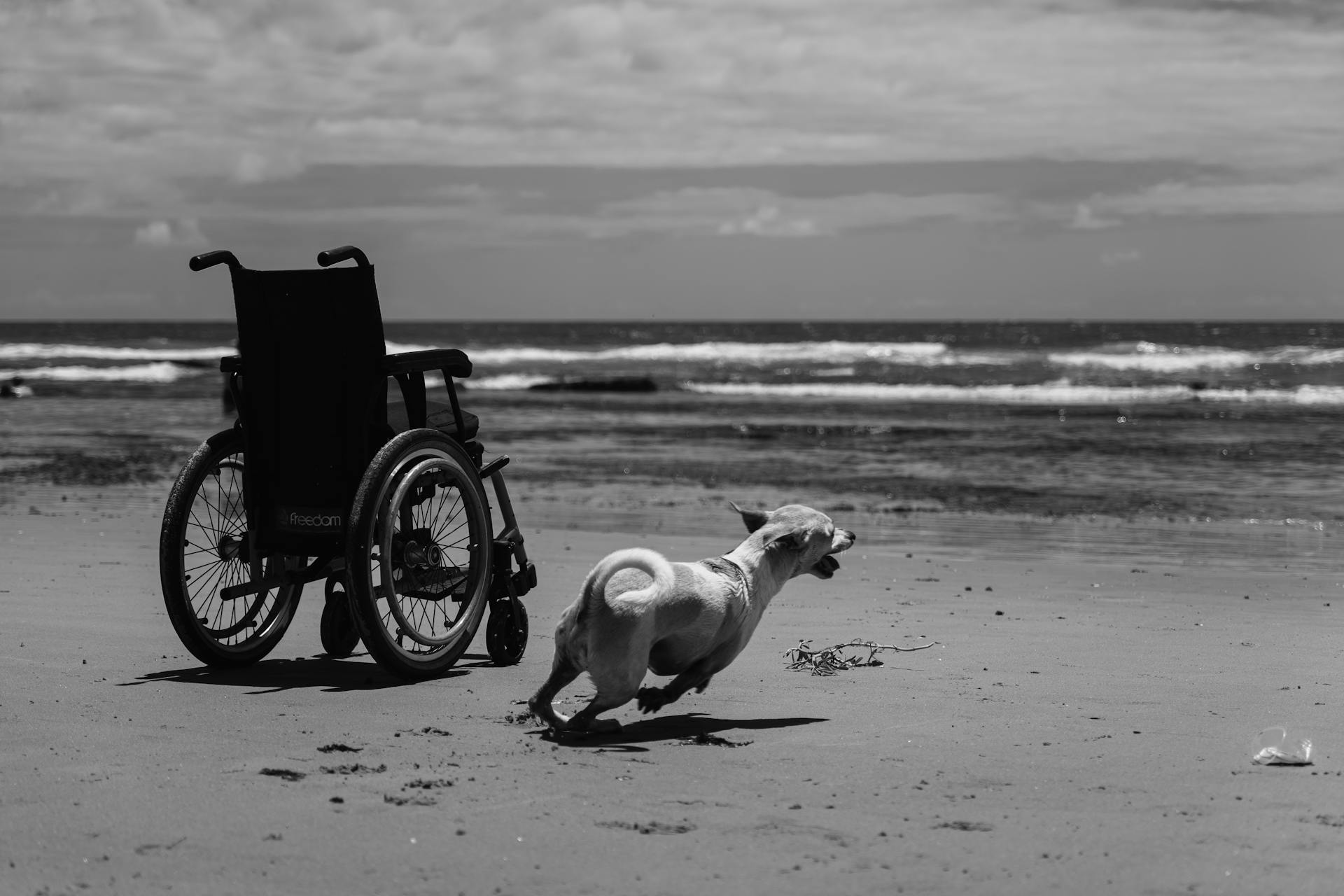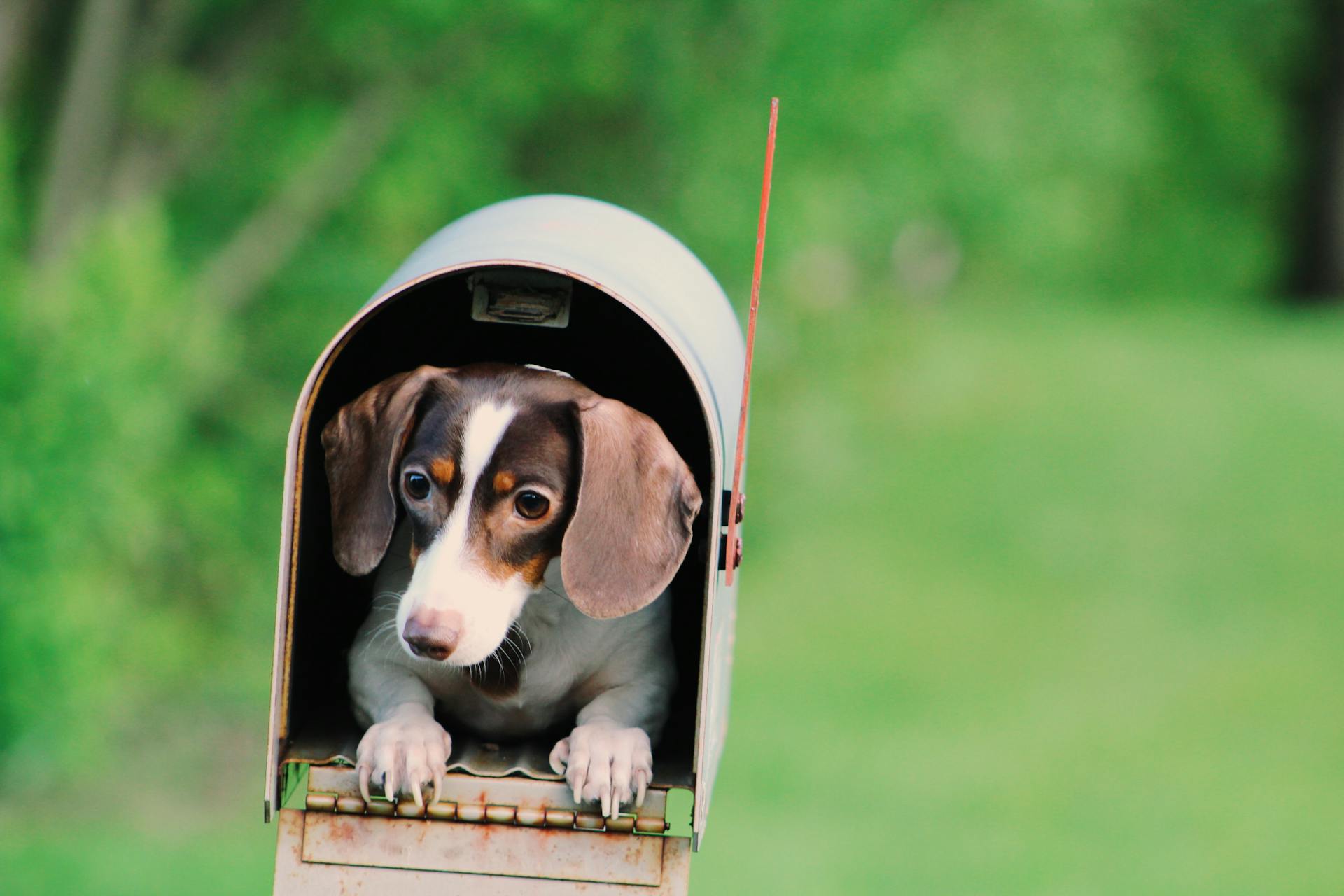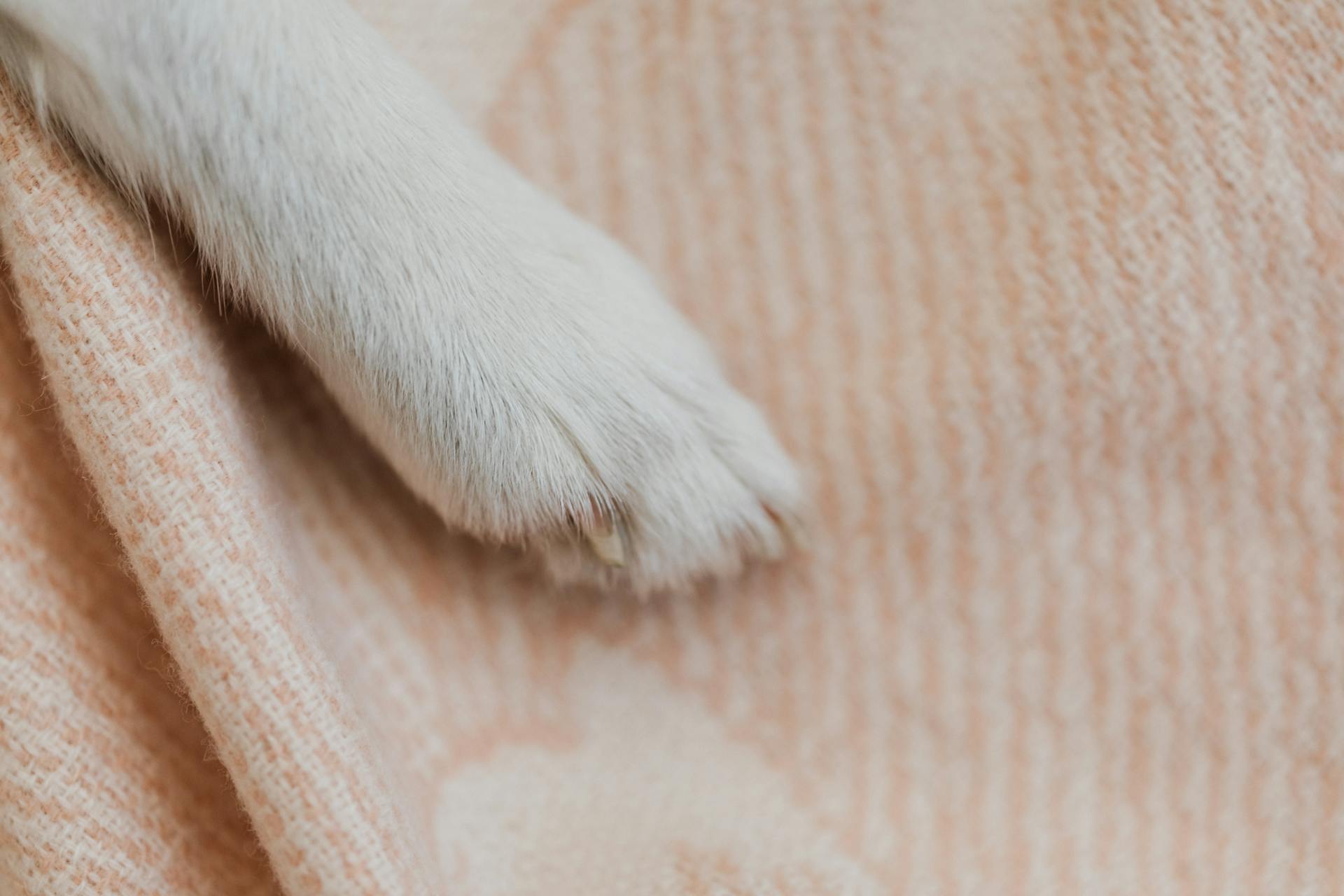
Degenerative myelopathy in dogs can be a devastating diagnosis for pet owners. The disease is a progressive neurological disorder that affects a dog's spinal cord, leading to loss of motor function and mobility.
Symptoms typically begin with weakness or stiffness in the hind legs, progressing to paralysis. This can happen over a period of weeks to months.
Treatment for degenerative myelopathy in dogs is largely focused on managing symptoms and improving quality of life. Medications like corticosteroids and pain relievers can help alleviate pain and discomfort.
A veterinary neurologist can help determine the best course of treatment for a dog with degenerative myelopathy, as they can provide a more detailed diagnosis and personalized recommendations.
Readers also liked: Dog Flea Treatment Overdose Symptoms
Genetics
Degenerative myelopathy is a complex disease with a genetic component, and understanding the genetics can help with treatment and management.
The genetics of degenerative myelopathy involve a mutation in the SOD1 gene, which is associated with familial amyotrophic lateral sclerosis (ALS) in humans. This mutation is a risk factor for developing degenerative myelopathy in several breeds.
A DNA test can help determine if your dog carries genetic risks for DM, but it's not a guarantee of the disease. Some experts believe attributing DM to just a SOD1 variant may be an oversimplification, as other factors seem to influence whether or not the SOD1 variant is expressed.
The SOD1 variant is widespread in many breeds, but the actual rates of DM diagnosis in some breeds are far lower than expected. For example, only 25% of German Shepherd Dogs with symptoms actually have Degenerative Myelopathy.
Here's a breakdown of the genetic risks for DM in dogs:
Some breeds are more susceptible to Degenerative Myelopathy than others, and testing is recommended for breeds where the University of Missouri has proven susceptibility through microscopic examination of spinal cords from deceased dogs.
Discover more: Dog Breeds Watch Dogs
Treatment and Management
Degenerative myelopathy is a progressive disease with no cure, but there are ways to slow its progression and improve your dog's quality of life. Laser therapy may help slow the disease, and recent studies suggest it can be used in conjunction with rehabilitation and acupuncture.
Exercise is crucial for maintaining your dog's ability to walk, and physiotherapy may prolong the length of time they remain mobile. Canine hydrotherapy, or swimming, may be more useful than walking. A belly sling or hand-held harness can support your dog's hind legs for exercising or going up and down stairs.
Physical therapy is essential for dogs with degenerative myelopathy, and it can improve mobility, slow down disease progression, and increase overall strength. A multi-modal treatment plan should include physical therapy, hydrotherapy, massage, acupuncture, and laser therapy to stimulate the nervous system. Balanced nutrition is also crucial.
Here are some assistive equipment options to support your dog's changing mobility needs:
- Slings and harnesses for lifting support
- Pet boots to protect dragging paws
- Training tools for paw placement and gait training
- Dog wheelchairs for support and mobility
A dog wheelchair can help your dog stay active, increase strength, and lower the chance of muscle atrophy. It can also offer progressive support that adapts to your dog's changing needs and enhance rehabilitation sessions. Regular exercise can help slow down disease progression, so it's essential to find ways to keep your dog active.
Researchers are exploring new treatments, including a drug called riluzole, which has shown promise in prolonging life in human ALS patients. A collaborative project called Project DM aims to evaluate riluzole's safety, efficacy, and potential as a treatment for degenerative myelopathy in dogs.
How Is DM Diagnosed?
Diagnosing DM in dogs can be a challenging process, but your vet will start by looking for signs consistent with the disease, such as gradual rear end weakness.
Rear end weakness can be caused by other problems, so it's not a definitive indicator of DM. Your vet will need to rule out other possibilities before making a diagnosis.
This process is called diagnosis of exclusion. Your vet will perform tests such as blood work, radiographs, and spinal fluid analysis to rule out other conditions.
Myelography, computed tomography, and magnetic resonance imaging can also be used to help diagnose DM. These tests can provide detailed images of the spinal cord and surrounding tissue.
Electromyography and nerve conduction studies can show abnormal results in dogs with DM, especially in the later stages of the disease. These tests can help your vet determine the extent of nerve damage.
You might enjoy: Vet Dogs Dog Treats
Understanding and Progression
Degenerative myelopathy progresses at a different pace for every dog, with some experiencing a rapid decline and others slowly losing control of their legs over the course of months.
The first signs of DM can be subtle, like your dog dragging a rear foot or having a wobbly gait. These early signs can be easy to overlook, but it's essential to catch them early to slow the progression of the disease.
Some breeds, like Pembroke Welsh Corgis, German Shepherd Dogs, Boxers, Rhodesian Ridgebacks, and Chesapeake Bay Retrievers, seem to be more common in DM cases. This may be due to genetic factors or other underlying health conditions.
Signs and Symptoms
The first signs of DM can be subtle, like your dog dragging a rear foot, having a wobbly gait, or taking a wrong step here or there.
As the disease progresses, signs of canine DM become more apparent, including swaying, falling to the side, loss of coordination, worn nails on the rear paws, and walking on their knuckles.
Difficulty getting up is a common symptom, and your dog may also have trouble controlling their pooping and peeing.

Paralysis is a major concern, starting with the rear legs, then moving forward to the front legs, and potentially even affecting the head.
Not peeing can be a medical emergency, so if your dog hasn't peed in 24 hours, you'll need to bring them to the vet right away.
Some breeds, like Pembroke Welsh Corgis, German Shepherd Dogs, Boxers, Rhodesian Ridgebacks, and Chesapeake Bay Retrievers, seem to be more prone to DM.
Here's an interesting read: Degenerative Myelopathy Old Dog Back Legs Collapsing
Prognosis
The prognosis for Degenerative Myelopathy is generally poor, with aggressive therapy extending life expectancy to around 14 months.
Even with treatment, it's often recommended to consider euthanasia at around 12 months to prevent unnecessary suffering.
Without treatment, survival is typically around 3 months, as the disease progresses rapidly.
Some dogs have lived for many years with the disease, with one female boxer even living for 11 years.
This is a rare exception, but it's a testament to the individual variability of the disease.
The dog begins to realize it is ill during the late stages, which can be a difficult time for both the dog and its owner.
In some cases, dogs have even appeared to be combating the disease on their own, walking on their own and doing exercise.
Frequently Asked Questions
What are the 5 stages of degenerative myelopathy in dogs?
Degenerative myelopathy in dogs progresses through 5 stages, from early signs of neurological deficits to complete paralysis and final stage ascending paralysis. Understanding these stages is crucial for providing proper care and management for affected dogs.
Is walking good for dogs with degenerative myelopathy?
Yes, walking is beneficial for dogs with degenerative myelopathy as it can help slow down the disease's progression and maintain muscle strength
What can be mistaken for degenerative myelopathy in dogs?
Degenerative myelopathy can be mistaken for arthritis or hip dysplasia, especially in larger breeds, due to similar joint pain and weakness symptoms. Early signs may also resemble "knuckling" or hind paws turning in.
Sources
- https://en.wikipedia.org/wiki/Canine_degenerative_myelopathy
- https://www.dvm360.com/view/degenerative-myelopathy-diagnosis-and-treatment-proceedings
- https://www.walkinpets.com/blog/understanding-degenerative-myelopathy-dm/
- https://www.akc.org/expert-advice/health/degenerative-myelopathy-in-dogs/
- https://ofa.org/degenerative-myelopathy/
Featured Images: pexels.com


